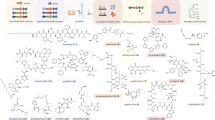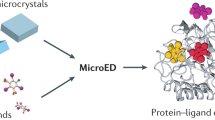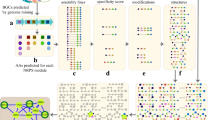Abstract
More than 60% of pharmaceuticals are related to natural products (NPs), chemicals produced by living organisms. Despite this, the rate of NP discovery has slowed over the past few decades. In many cases the rate-limiting step in NP discovery is structural characterization. Here we report the use of microcrystal electron diffraction (MicroED), an emerging cryogenic electron microscopy (CryoEM) method, in combination with genome mining to accelerate NP discovery and structural elucidation. As proof of principle we rapidly determine the structure of a new 2-pyridone NP, Py-469, and revise the structure of fischerin, an NP isolated more than 25 years ago, with potent cytotoxicity but hitherto ambiguous structural assignment. This study serves as a powerful demonstration of the synergy of MicroED and synthetic biology in NP discovery, technologies that when taken together will ultimately accelerate the rate at which new drugs are discovered.

This is a preview of subscription content, access via your institution
Access options
Access Nature and 54 other Nature Portfolio journals
Get Nature+, our best-value online-access subscription
$29.99 / 30 days
cancel any time
Subscribe to this journal
Receive 12 print issues and online access
$259.00 per year
only $21.58 per issue
Buy this article
- Purchase on Springer Link
- Instant access to full article PDF
Prices may be subject to local taxes which are calculated during checkout




Similar content being viewed by others
Data availability
Crystallographic information files (CIFs) for compounds 2, 3 and 8 containing atomic coordinates and structure factors have been deposited at the Cambridge Crystallographic Data Center (deposition numbers 2020516, 2038723 and 2020510, respectively). Copies of the data can be obtained free of charge at https://www.ccdc.cam.ac.uk/structures/. Source data for Extended Data Fig. 5 has been provided in Supplementary Table 6.
References
Newman, D. J. & Cragg, G. M. Natural products as sources of new drugs over the nearly four decades from 01/1981 to 09/2019. J. Nat. Prod. 83, 770–803 (2020).
Perfect, J. R. The antifungal pipeline: a reality check. Nat. Rev. Drug Discov. 16, 603–616 (2017).
Fair, R. J. & Tor, Y. Antibiotics and Bacterial Resistance in the 21st Century. Perspect. Medicin. Chem. 6, 25–64 (2014).
Pye, C. R., Bertin, M. J., Lokey, R. S., Gerwick, W. H. & Linington, R. G. Retrospective analysis of natural products provides insights for future discovery trends. Proc. Natl Acad. Sci. USA 114, 5601–5606 (2017).
Fisch, K. M. et al. Rational domain swaps decipher programming in fungal highly reducing polyketide synthases and resurrect an extinct metabolite. J. Am. Chem. Soc. 133, 16635–16641 (2011).
Nicolaou, K. C. & Snyder, S. A. Chasing molecules that were never there: misassigned natural products and the role of chemical synthesis in modern structure elucidation. Angew. Chem. Int. Ed. 44, 1012–1044 (2005).
Maier, M. E. Structural revisions of natural products by total synthesis. Nat. Prod. Rep. 26, 1105–1124 (2009).
Bifulco, G., Dambruoso, P., Gomez-Paloma, L. & Riccio, R. Determination of relative configuration in organic compounds by NMR spectroscopy and computational methods. Chem. Rev. 107, 3744–3779 (2007).
Jones, C. G. et al. The CryoEM method MicroED as a powerful tool for small molecule structure determination. ACS Cent. Sci. 4, 1587–1592 (2018).
Gruene, T. et al. Rapid structure determination of microcrystalline molecular compounds using electron diffraction. Angew. Chem. Int. Ed. 57, 16313–16317 (2018).
Rodriguez, J. A. et al. Structure of the toxic core of α-synuclein from invisible crystals. Nature 525, 486–490 (2015).
Jones, C. J. et al. Characterization of reactive organometallic species via MicroED. ACS Cent. Sci. 5, 1507–1513 (2019).
Hayakawa, S., Minato, H. & Katagiri, K. The ilicicolins, antibiotics from Cylindrocladium ilicicola. J. Antibiot. 24, 653–654 (1971).
Du, L. et al. Crowdsourcing natural products discovery to access uncharted dimensions of fungal metabolite diversity. Angew. Chem. Int. Ed. 53, 804–809 (2014).
Miyadera, H. et al. Atpenins, potent and specific inhibitors of mitochondrial complex II (succinate-ubiquinone oxidoreductase). Proc. Natl Acad. Sci. USA 100, 473–477 (2003).
Ziemert, N., Alanjary, M. & Weber, T. The evolution of genome mining in microbes – a review. Nat. Prod. Rep. 33, 988–1005 (2016).
Singh, S. B. et al. Antifungal spectrum, in vivo efficacy, and structure–activity relationship of ilicicolin H. ACS Med. Chem. Lett. 3, 814–817 (2012).
Zhang, Z. et al. Enzyme-catalyzed inverse-electron demand Diels–Alder reaction in the biosynthesis of antifungal ilicicolin H. J. Am. Chem. Soc. 141, 5659–5663 (2019).
Liu, N. et al. Identification and Heterologous production of a benzoyl-primed tricarboxylic acid polyketide intermediate from the zaragozic acid A biosynthetic pathway. Org. Lett. 19, 3560–3563 (2017).
Alfatafta, A. A., Gloer, J. B., Scott, J. A. & Malloch, D. Apiosporamide, a new antifungal agent from the coprophilous fungus Apiospora montagnei. J. Nat. Prod. 57, 1696–1702 (1994).
Williams, D. R., Kammler, D. C., Donnell, A. F. & Goundry, W. R. F. Total synthesis of (+)-apiosporamide: assignment of relative and absolute configuration. Angew. Chem. Int. Ed. 44, 6715–6718 (2005).
Fujimoto, H., Ikeda, M., Yamamoto, K. & Yamazaki, M. Structure of fischerin, a new toxic metabolite from an ascomycete, Neosartorya fischeri var. fischeri. J. Nat. Prod. 56, 1268–1275 (1993).
Amini, S. K. Assignment of the absolute configuration of fischerin by computed nmr chemical shifts. J. Struct. Chem. 56, 1334–1341 (2015).
Ugai, T., Minami, A., Gomi, K. & Oikawa, H. Genome mining approach for harnessing the cryptic gene cluster in Alternaria solani: production of PKS–NRPS hybrid metabolite, didymellamide B. Tetrahedron Lett. 57, 2793–2796 (2016).
Skiba, M. A. et al. Domain organization and active site architecture of a polyketide synthase C-methyltransferase. ACS Chem. Biol. 11, 3319–3327 (2016).
Nannenga, B. L. MicroED methodology and development. Struct. Dyn. 7, 014304, https://doi.org/10.1063/1.5128226 (2020).
de la Cruz, M. J. et al. Atomic-resolution structures from fragmented protein crystals with the cryoEM method MicroED. Nat. Methods 14, 399–402 (2017).
Dubochet, J. et al. Cryo-electron microscopy of vitrified specimens. Q. Rev. Biophys. 21, 129–228 (1988).
Natesh, R. in Structural Bioinformatics: Applications in Preclinical Drug Discovery Process, Edition 1, Vol. 27 (ed. Mohan, C. G.) 375–400 (Springer Nature, 2019).
Kato, K. et al. A vault ribonucleoprotein particle exhibiting 39-fold dihedral symmetry. Acta Cryst. D64, 525–531 (2008).
Matsuda, Y. & Abe, Ikuro Biosynthesis of fungal meroterpenoids. Nat. Prod. Rep. 33, 26–53 (2016).
Ohashi, M. et al. SAM-dependent enzyme-catalysed pericyclic reactions in natural product biosynthesis. Nature 549, 502 (2017).
Liu, N. et al. Identification and Heterologous production of a benzoyl-primed tricarboxylic acid polyketide intermediate from the zaragozic acid A biosynthetic pathway. Org. Lett. 19, 3560–3563 (2017).
Nannenga, B. L., Shi, D., Leslie, A. G. W. & Gonen, T. High-resolution structure determination by continuous-rotation data collection in MicroED. Nat. Methods 11, 927–930 (2014).
Hattne, J. et al. MicroED data collection and processing. Acta Cryst. A71, 353–360 (2015).
Kabsch, W. XDS. Acta Cryst. D66, 125–132 (2010).
Kabsch, W. Integration, scaling, space-group assignment and post-refinement. Acta Cryst. D66, 133–144 (2010).
Sheldrick, G. M. A short history of SHELX. Acta Cryst. A64, 112–122 (2008).
Sheldrick, G. M. SHELXT – Integrated space-group and crystal-structure determination. Acta Cryst. A71, 3–8 (2015).
Sheldrick, G. M. Crystal structure refinement with SHELXL. Acta Cryst. C71, 3–8 (2015).
Hübschle, C. B., Sheldrick, G. M. & Dittrich, B. ShelXle: a Qt graphical user interface for SHELXL. J. Appl. Cryst. 44, 1281–1284 (2011).
Delano, W. The PyMOL Molecular Graphics System version 2.3.3 (Schrödinger LLC, 2019); http://www.pymol.org
Van Rossum, G. & Drake, F. L. Python 3 Reference Manual (CreateSpace, 2009).
Acknowledgements
The authors thank M. R. Sawaya (UCLA-DOE Institute) for assistance in crystallography in data processing and refinement. This research used resources at the X-ray Crystallography Core Facility of the UCLA-DOE Institute, which is supported by the US Department of Energy (DE-FC02-02ER63421). J.A.R. acknowledges support from STROBE, an NSF Science and Technology Center through Grant DMR-1548924, DOE Grant DE-FC02-02ER63421 and NIH-NIGMS Grant R35 GM128867. J.A.R. is supported as a Pew Scholar and a Beckman Young Investigator. Y.T. acknowledges support from the NIH (1R01AI141481). The authors also thank the David and Lucile Packard Foundation (Fellowships to H.M.N., J.A.R. and Y.T.) and Bristol Myers Squibb (Unrestricted Grant in Synthetic Organic Chemistry to H.M.N.) for generous support.
Author information
Authors and Affiliations
Contributions
H.M.N. and Y.T. supervised the project. M.O., Z.Z. and D.T. performed in vivo experiments, as well as compound isolation and characterization. L.J.K. performed crystallization experiments, collected and processed the MicroED data, and solved the structures. L.J.K. and M.A. refined the structures. D.C. assisted in structure refinement. L.J.K. and D.C. performed the atom substitution test. J.A.R. assisted in designing MicroED experiments and helped with MicroED data analysis. L.J.K. and M.O. prepared the figures. H.M.N., Y.T., L.J.K. and M.O. wrote the manuscript.
Corresponding authors
Ethics declarations
Competing interests
The authors declare no competing interests.
Additional information
Publisher’s note Springer Nature remains neutral with regard to jurisdictional claims in published maps and institutional affiliations.
Extended data
Extended Data Fig. 1 Biosynthetic gene clusters that are homologous to those of fischerin (2) and N-hydroxyapiosporamide (7); and multiple sequence alignment of SAM-binding motif of cis-MT domain in PKS-NRPSs.
Shown here are the putative biosynthetic gene clusters of 2 and 7 and their homologous biosynthetic gene clusters found in NCBI database. SAM binding motif is shown in an alignment with those from FinD and ApiD homologs. Previous study reported that active cis-MT domains contain conserved EXGXGTG sequence as a SAM binding motif23. Based on this, we hypothesized that the cis-MT domains in PKS-NRPSs which do not have this conserved this motif are inactive, and the biosynthetic gene clusters which contain the PKS-NRPSs could be responsible for formation of 2. For example, the cis-MT domains from FinD (Aspergillus carbonarius), CG_v00450 (Colletotrichum fructicola Nara gc5), and BO_621233 (Aspergillus sclerotioniger) do not contain this conserved EXGXGTG motif as the threonine residues are mutated to alanines. As shown in Fig. 3d, the biosynthetic gene cluster, which contains FinD, is indeed responsible for formation of 2.
Extended Data Fig. 2
1H NMR spectra of 2 in CDCl3, 500 MHz for 1H NMR.
Extended Data Fig. 3 Proposed biosynthetic pathway of 2.
Based on the reported proposed biosynthetic pathway of other 2-pyridone alkaloids such as leporins and ilicicolin H (3) (see Extended Data Fig. 1a), we proposed the biosynthetic pathway of 2. FinD (PKS-NRPS) and the partnering FinC (ER) form the tetramic acid intermediate. A P450 FinE catalyzes the oxidative ring-expansion reaction of the tetramic acid to the 2-pyridone compound. Then, a Diels-Alderase likely catalyze the Diels-Alder reaction to form the energetically disfavored cis-decalin ring, since the previous study24 showed that nonenzymatic Diels-Alder reaction of the analog of 2-pyridone compound in water only led to formation of the trans-decalin compound. Further redox modification by FinA, FinE, and FinH forms 2.
Extended Data Fig. 4
Atom substitution test for fischerin (2) with (top) and without (bottom) electron scattering factors.
Extended Data Fig. 5 Electron microgram of austinol crystal and its diffraction pattern from 3 ng of sample.
Holes are 1 µm wide in diameter.
Supplementary information
Supplementary Information
Supplementary Figs. 1–26, Notes and Tables 1–13.
Supplementary Data 1
Crystallographic data containing structure factors for Py-469.
Supplementary Data 2
Crystallographic data containing structure factors for fischerin.
Supplementary Data 3
Crystallographic data containing structure factors for austinol.
Rights and permissions
About this article
Cite this article
Kim, L.J., Ohashi, M., Zhang, Z. et al. Prospecting for natural products by genome mining and microcrystal electron diffraction. Nat Chem Biol 17, 872–877 (2021). https://doi.org/10.1038/s41589-021-00834-2
Received:
Accepted:
Published:
Issue Date:
DOI: https://doi.org/10.1038/s41589-021-00834-2
This article is cited by
-
Accelerating the design of pili-enabled living materials using an integrative technological workflow
Nature Chemical Biology (2024)
-
Artificial intelligence for natural product drug discovery
Nature Reviews Drug Discovery (2023)



